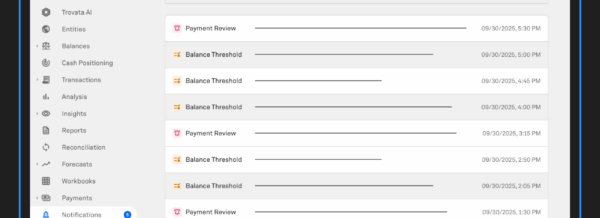The recent US Fed rate cut by 50 basis points—the largest reduction in four years—marks a significant shift in the financial landscape. For corporate treasury teams, this presents a mix of opportunities and challenges. Lower borrowing costs can open the door to refinancing existing debt, securing new loans, and exploring more diverse investment options.
However, to capitalize on these opportunities, treasury teams need to have a solid understanding of their cash positions and liquidity needs.
As companies look to navigate this new rate environment, treasury teams need to be asking two crucial questions:
1. Where is our cash?
2. When might we need to access it?
In this article, we’ll explore how corporate treasury can respond to this changing environment, optimize cash positioning, and leverage modern tools to ensure they’re fully equipped to drive growth and maintain financial stability in the months ahead.

Key Questions Treasury Should Be Asking After the Fed Rate Cut
With interest rates decreasing, treasury teams need to act strategically to maximize the benefits of lower borrowing costs while minimizing risk. Let’s take a closer look at those two all-important questions.
Where is our cash?
In a fluctuating interest rate environment, full visibility into your cash positions is even more essential than usual. Knowing exactly where your cash is—across all accounts, regions, and subsidiaries—enables your team to make informed decisions about where to allocate idle funds, how to optimize liquidity, and how to maximize cash yields.
Without this level of transparency, opportunities to earn better returns or fund growth initiatives may be missed.
Tools that provide real-time visibility into cash positions, such as Trovata, allow treasury teams to track and manage cash across various accounts in a centralized platform.
By synthesizing all cash data into one place, teams can easily identify idle cash and redeploy it into higher-yielding investments, ensuring funds are working efficiently. At the same time, Treasurers can develop a clear understanding of their liquidity position, to allow them to respond quickly to threats or opportunities.
When do we need cash?
Equally important to knowing where your cash is located is understanding when you might need it. This is where cash flow forecasting becomes hugely beneficial. With interest rate policy beginning to loosen, treasury teams should revisit their short and long-term cash flow forecasts to ensure that they’re prepared to meet upcoming obligations, fund new projects, and take advantage of market conditions.
Scenario planning can also play an important role here, forecasting how the business might be impacted by various levels of lower (or stagnant) rates going forward.
A solid grasp of cash flow timing allows your team to ensure the right amount of liquidity is available at the right time, reducing the need to hold excessive amounts of idle cash in low-yield accounts. By optimizing cash positioning, you can invest surplus funds more effectively, whether in short-term money markets, T-bills, or longer-term, higher-yield options.
Answering these two questions is the foundation for making the most of the new easing interest rate cycle.
5 Actions Corporate Treasury Should Take
With those questions answered, corporate treasury teams can get more specific about the actions they need to take. It’s important to move quickly to capitalize on new opportunities that could come from easing rates, while ensuring they remain aligned with the company’s long-term financial goals.
Here are some key actions treasury teams should consider:
1. Review debt strategy
Lower interest rates present an opportunity for treasury teams to reassess their company’s debt strategy. Refinancing existing debt at a lower rate can reduce interest expenses and improve cash flow, freeing up capital for growth or other initiatives.
The lower cost of borrowing makes it a prime time to consider taking on new loans to fund projects, acquisitions, or other growth activities. By locking in favorable borrowing terms now, companies can strengthen their financial flexibility and improve their long-term financial outlook.
With that said, Treasurers should consider whether rates could fall further. If they do, it may be prudent to start strategic planning, but hold off on implementation until the Fed meets again.
Of course, no one knows for sure whether more rate cuts are on the horizon, so forecasting and scenario planning are the best tools to assess your options.
“In a recent conversation with my banking partners, I was able to instantly determine our credit needs by analyzing historical cash trends for a subset of our accounts completely on the fly. It is amazing I was able to do that for a solution that was setup with no IT resources required whatsoever. I’m constantly impressed with how easy it is to use and gain insights from Trovata.”
Aurelia Sirbu – CFO at Orbus
2. Optimize cash flow forecasting
As mentioned earlier, now is a great time for treasury teams to revisit their cash flow forecasts to ensure they accurately reflect the company’s current position. After all, this is the first rate change since July 2023, so it’s been some time since we’ve seen any changes to these baseline numbers.
Having a detailed understanding of when cash will be required helps optimize cash positioning, ensuring the company isn’t holding excessive idle cash in low-yield accounts, while ensuring sufficient liquidity for operations.
Treasury teams should also be thinking about long-term interest rate planning. By extending the time horizon of cash flow forecasting, they can make more informed decisions about locking in yields on longer-term investments, including corporate bonds, equities, or fixed-income securities.
The key is balancing risk and return based on the company’s cash needs and risk tolerance.
3. Evaluate alternative investments
As returns on traditional short-term cash investments fall with interest rates, treasury teams should research alternative investment options to generate higher returns on excess cash. While money market funds, T-bills, and CDs remain safe and reliable, lower rates make them less attractive.
Treasury teams may need to consider higher-risk, higher-return investments, such as corporate bonds or other long-term fixed-income securities. Of course, the potential increase in return from these assets should be carefully weighed against the additional risk that comes with them.
4. Review currency exposure
A lower interest rate environment may lead to a weaker U.S. dollar against currencies maintaining a tighter interest rate policy. This can have implications for companies with international operations or significant foreign currency exposure.
Treasury teams should review their currency risk and consider hedging strategies to mitigate the impact of a depreciating dollar. This could involve adjusting currency hedging strategies, rebalancing currency holdings, or reviewing contracts with international suppliers and clients.
5. Assess cash yields
Idle cash sitting in low-yield accounts is a missed opportunity in a lower interest rate environment. Treasury teams should assess their current idle cash management strategies and explore the use of sweep accounts or money market portals to automatically move excess cash into higher-yielding accounts.
This allows the company to maximize returns on surplus funds without sacrificing liquidity.
3 End of Year Considerations for Corporate Treasury
All of these suggestions have a similar theme. That’s one of stocktake and review. With a change in interest rate policy and the end of the year approaching, treasury teams should look to take a proactive approach to their preparations for next year.
1. Unspent budget? Put it to work
For companies with unspent budgets nearing year-end, this is an opportunity to reassess how idle funds are being managed. We’ve already discussed the importance of maximizing yield on this cash, but this is also a great time to consider investments that could be made with that cash.
As interest rates fall, the opportunity cost of leaving cash stagnant becomes greater.
2. Setting next year’s budget
As treasury teams begin planning for the next fiscal year, it’s important to ensure that cash management and liquidity strategies are fully aligned with the company’s broader financial goals.
Start by reviewing this year’s performance—did you have unutilized cash sitting in low-yield accounts? Were there missed opportunities for investment?
Treasury teams should consider leveraging cash aggregation platforms like Trovata to centralize data from across the organization, giving them a comprehensive view of cash positions, inflows, and outflows. This can simplify reporting and improve cash forecasting, ensuring a clearer, more accurate view of next year’s cash needs.
With a real-time understanding of cash flow, treasury can create a more effective budget that optimizes liquidity and maximizes returns.
3. Start January fresh with global bank visibility
Looking ahead to 2025, treasury teams should aim to start the new year with global bank visibility. By implementing systems that provide a unified view of cash across all accounts, regions, and subsidiaries, treasury can improve cash positioning and liquidity management from day one.
Global visibility not only simplifies cash management but also helps treasury teams respond more quickly to market changes and interest rate shifts. By having a comprehensive, real-time view of global cash balances, treasury teams can better manage working capital, improve financial reporting, and prepare the organization for sustained growth in the year ahead.
Stay Flexible and Adaptable With Trovata
As interest rates decrease and economic conditions shift, corporate treasury teams have to stay agile and strategic to capitalize on opportunities and manage risks. From refinancing debt and optimizing cash flow forecasting to improving investment strategies and ensuring real-time cash visibility, having the right tools is critical to navigating these changes effectively.
Trovata offers a comprehensive suite of features designed to help treasurers manage cash and liquidity in real-time, empowering them to respond quickly to fluctuations in interest rates and other economic factors.

With direct bank connectivity through APIs and legacy file formats, Trovata automatically consolidates and normalizes cash data, providing a single source of truth across all your bank accounts. This real-time visibility allows treasurers to track cash positions accurately and allocate idle funds to higher-yielding investments, without hours of manual work each week.

Trovata’s customizable tagging system further enhances cash management by enabling treasury and accounting teams to categorize transactions effectively, simplifying reconciliation and reporting. The TQL search feature makes it easy to locate specific transactions, allowing teams to streamline workflows and focus on strategic decision-making.
Transform your finance and treasury operations. Book a demo today.




